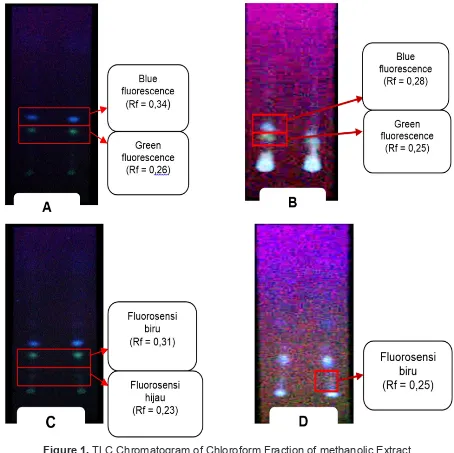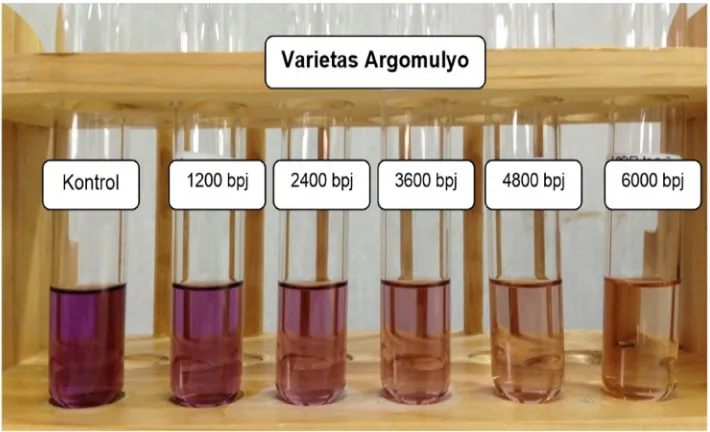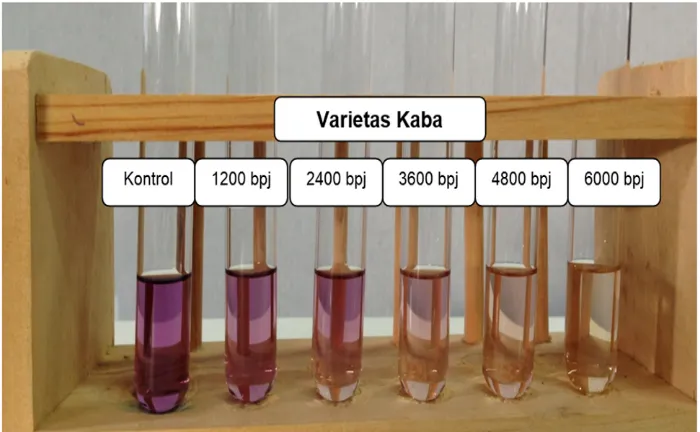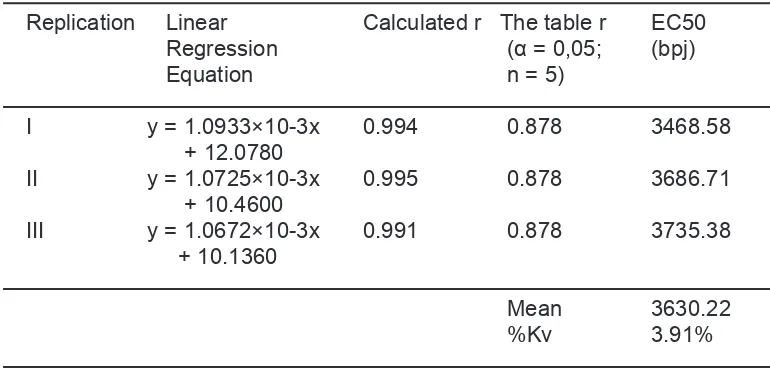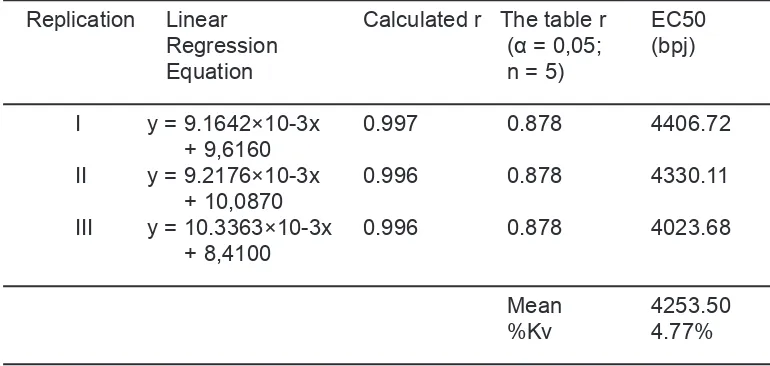An Assay of Antioxidant Power of Methanolic Extract Various
Type of Soybean
Rika Yulia, Azminah, Michella & Andre Tanzil
ABSTRACT: This study aimed to examine the antioxidant activity of methanolic
extract of various type of soybean (Glycine max L.Merill) i.e Argomulyo,
Burangrang, Ijen, and Kaba by using DPPH (1,1-Diphenyl-2-picryhydrazyl)
method. The soybean was crushed, defatted using n-hexan, and extracted using
methanol 90%. The processes of defatting and extracting were conducted by
kinesthetic maceration. Identification of flavonoid content using KLT and an
assay of the antioxidant power of soybean were carried out qualitatively and
quantitavely. Qualitative analysis, the color of DPPH solution was fading from
violet into yellowish. Quantitative analysis showed that the maximum
wave-length of DPPH in methanol was 516,00 nm within 15-minute reaction time.
The effective concentration 50% (EC50) of each extract was alsa determined.
Results of this study revealed that the methanolic extract of soybean taken from
varieties of Argomulyo, Burangrang, Ijen, and Kaba contained flavonoid, with
EC50 value of each variety subsequently ranging from 3620.22 bpj; 5290.71 bpj;
4145.99 bpj; and 4253.50 bpj. Argomulyo variety showed the highest antioxidant
power. Keywords:
Soybean (Glycine
max L.Merill),
Argomulyo variety,
Burangrang
variety, Ijen
variety,
Kaba variety,
antioxidant
power, DPPH
(1,1-Diphenyl-2-picryhydrazyl)
Faculty of Pharmacy, University of Surabaya
Korespondensi:
Rika Yulia
ARTIKEL PENELITIAN
Jurnal Sains Farmasi & Klinis (ISSN: 2407-7062) | Vol. 01 No. 02 | Mei 2015
Jurnal Sains Farmasi & Klinis, 1(2), 122-131
122
INTRODUCTION
Nowadays, free radicals and antioxidant
have become one of the issues the health
practitioners frequently talk about. This is
because most of the illnesses are claimed
to be correlated with excessive oxidation
reaction in the body. Such reaction initiates
the forming of very active free radicals, which
later results in cell or tissue impairment,
autoimmune diseases, degenerative
diseases and cancer (1).
Reactivity of free radicals might be
hampered by means of antioxidant activities
in a system. In fact, human’s body already has
natural antioxidant to reduce cell impairment.
The problem is that free radicals could
develop faster with the amount outweigh the
natural antioxidant formed within the body.
Therefore, there is a need for additional
antioxidant intake to help protecting the
body from free radicals and minimizing their
negative effects. Flavonoid is wellknown as
good antioxidant
Soybeans (Glycine max L.Merill) appear
to be one of the plants contain flavonoids
which is known as antioxidant component
and which is widely spread and easily found
in Indonesia. Soybeans contain flavonoid derivatives classified as fitoestrogen category and it is called isoflavones. The primary isoflavones contained in the
soybeans are genistein and daidzein (1).
Most of the isoflavones in the soybeans are
available in the form of glycoside, only few
in the aglycone form (2). The existence of
sugar tied to aglycone isoflavone (glycoside form) causes glycoside isoflavone to
dissolve more easily in the polar solution,
such as ethanol, methanol, butanol, acetone,
dimethylsulfoxide, dimethylformamide and
An Assay of Antioxidant Power of Methanolic Extract … | Yulia, dkk.
Jurnal Sains Farmasi & Klinis (ISSN: 2407-7062) | Vol. 01 No. 02 | Mei 2015
123
water. Meanwhile, aglycones dissolve faster
on ether and chloroform (3).
In Indonesia, Balai Penelitian
Kacang-kacangan dan Umbi-umbian, Malang
(Balitkabi-Nuts and Tubers Research Center)
has issued superior soybean varieties in
Indonesia since 1918. By 2005, there had
been 62 soybean varieties entitled to be
superior (4). According to Lee et al. (2003),
genetic and environmental influences
contributed to the differences of genistein,
daidzein and total isoflavone content. High content of total isoflavone is related to high
antioxidant power (5).
Therefore, there should be studies on
the determination of the antioxidant power
of various type of soybean in Indonesia.
This study examined the antioxidant power
of four soybean varieties, i.e., Argomulyo,
Burangrang, Ijen, and Kaba by using DPPH
(1,1-Diphenyl-2-picryhydrazyl) method. The
antioxidant power of the soybeans (Glycine
max L.Merill) in reducing free radicals
DPPH was determined by calculation of
the EC50 (Effective Concentration 50).
EC50 is effective concentration to hamper
or reduce 50% of free radicals. Accordingly,
this study was expected to provide sufficient information regarding flavonoid contents and
antioxidant power of methanolic extract of
the four soybean varieties.
METHODS
Research Materials
The plants used in this study were
soybean (Glycine max L.Merill) varieties
of Argomulyo, Burangrang, Ijen, and Kaba
obtained from UPBS (Unit Pengelolaan
Benih Sumber-Seed Source Management
Jurnal Sains Farmasi & Klinis (ISSN: 2407-7062) | Vol. 01 No. 02 | Mei 2015
An Assay of Antioxidant Power of Methanolic Extract … | Yulia, dkk.
Unit) of Balitkabi (Nuts and Tubers Research
Center), Malang on August 26, 2013. Those
four varieties have been certified by Balitkabi,
Malang.
Chemical Substances
The chemical substances utilized in this
research included methanol p.a (Mallinckrodt
Chemicals), n-hexan p.a (Mallinckrodt
Chemicals), DPPH
(1,1-Diphenyl-2-picryhydrazyl), Silica gel GF254 (Merck),
aquadem (Chemistry Laboratory of University
of Surabaya).
Equipment
This research utilized an analytical scale
(AND GR-202), kinetic macerator (Stirring
Motor IKA Rw 20 N) with 10 rpm stirring speed,
rotary evaporator (heidolph), Ultrasonic
cleaner (Branson 1200), electric waterbath,
filter paper Whatmann, blender, siever mesh
20, stopwatch, spectrophotometer
UV-Visible (Shimadzu U-1800), Chromatography
instrument (CAMAG), capillary pipes 5 µl,
and laboratory glasses.
Preparation of the Research Materials
Each of soybean variety was cleaned,
dried in natural air, and later mashed using
the blender. The powder obtained was sifted
using siever mesh 20. Finally, the powder of
each variety was scaled up to 300 g each.
Extraction of the Soybeans
Firstly, the soybean powder was
macerated kinetically using 1 L n-hexan for
an hour. Then, it was left unprocessed for
24 hours. After 24 hours, it was sifted into a
container, while the residue was re-extracted
using n-hexan. The maceration process
using n-hexan was conducted 5 times.
The results of all the five processes were
collected in a container. This procedure was
done to extract the oil from soybean seeds.
Secondly, the residue was macerated
kinetically using 1 L methanol 90% for an
hour. It was let unprocessed again 24 hours.
The results, then, sifted into a container and
the remains were macerated using the same
technique. The kinetic maceration using
methanol 90% was conducted for 4 times. The
results of the first, second, third, and fourth
processes were collected in one container.
The liquid extract was later concentrated by
means of rotary evaporator to one third of
the initial volume. The concentration process
was continued in electric water bath until
viscous extract with constant weight was
obtained.
Identification of Flavonoid in Methanol
Extract of Soybeans
The viscous extract of the soybeans
was later dissolved in water, then it was
extracted by using chloroform for 3 times 10
ml in separate funnels. A qualitative analysis
of chloroform fraction was conducted using
a thin layer chromatography (TLC) method
to identify the presence of flavonoid in the
extract. The stationary phase used included
silica gel GF254 (Merck) and the mobile
phase was a mixture of CHCL3:ethyl acetate
(60:40). As much as 3 to 4 capillaries of
the extract were gently tapped ontoTLC
plate and eluted after saturation of the
chromatographic chamber. The plate was
then examined under the UV rays of 365 nm,
flavonoids showed yellow, blue and green fluorescence.
Qualitative Measurement of the
Antioxidant Power of methanolic Extract
of Soybeans (Glycine max L.Merill) using
124
DPPH Method
Each variety of the soybeans was scaled
as much as 300 mg and 50,0 mL methanol
was added (stock solution 6000 bpj). The
stock solution was diluted with methanol
to obtain concentrations 1200, 2400, 3600
and 4800 bpj respectively. Then, 1.5 ml of
each solution (1200 bpj, 2400 bpj, 3600 bpj,
4800 bpj, and 6000 bpj) was drawn into a
pipette and 3,0 mL, 40,0 bpj DPPH solution
was added. Each of solution sample was
evaluated in terms of the color change (the
purple color of DPPH solution would turn into pale yellow and finally colorless).
Determination of the Maximum
Wave-Length
As much as 3.0 ml of DPPH solution
40.0 bpj and 1.5 ml of methanol were put
in a test tube, shaken homogeneously, and
finally observed in terms of the absorbance in λ 400-700 nm. The wave-length with the
highest absorbance was the maximum
wave-length.
Determination Reaction Time
As much as 3.0 ml of DPPH solution
40.0 bpj and 1.5 ml of methanol were put
ini a test tube, shaken homogeneously, and
finally observed in terms of the absorbance in λ 400-700 nm within the interval of 5, 10,
15, 20, 25, and 30 minutes. As a comparison,
3.0 ml of DPPH solution 40.0 bpj and 1.5 ml
of methanol were used.
Quantitative Measurement of the
Antioxidant power of the Soybean
Methanolic Extract
3,0 mL 40,0 bpj DPPH solution and 1,5
mL sample solution at various concentration
(1200, 2400, 3600, 4800, and 6000 bpj) were
An Assay of Antioxidant Power of Methanolic Extract … | Yulia, dkk.
mixed homogenously and left for a period of
time to provide optimum reaction (based on
the reaction time determined previously).
Afterwards, the mixture was observed at the
maximum wave-length. As a comparison, 3.0
ml of DPPH 40.0 bpj and 1.5 ml of methanol
were used. This activity was replicated for 3
times.
Data Analysis
The antioxidant power was calculated
from the percentage of damping by using the
following formula:
If the value showed 0%, the solution had
no free radical damping power, on the other
hand, if the value showed 100% value, it
implied that the solution totally had damping
power. The testing needed to be continued
by diluting the sample solution in order to
observe its concentration limit.
The percentage (%) of the damping
at various concentration was later put
into regression equation with extract
concentration (bpj) as the axis (X) and the
percentage value of the damping as the
ordinate (Y). The value of EC50 was obtained
from calculating the percentage of damping
as much as 50%. In this study, The value of
EC50of 4 soybean varieties will be compared
using statistics method of One-way ANOVA.
EC50was an effective concentration to
hamper or to reduce 50% of free radicals (6).
From the linear regression equation
of concentration vs damping percentage,
correlation between the sample solution
concentration (X) and the percentage of
damping (Y) could be attained by calculating
the correlation coefficient r (α = 0.05). If the
Jurnal Sains Farmasi & Klinis (ISSN: 2407-7062) | Vol. 01 No. 02 | Mei 2015
125
An Assay of Antioxidant Power of Methanolic Extract … | Yulia, dkk.
value of r is bigger than the value of r listed
in the table within α = 0.05, it entailed that there was a significant correlation between
the concentration of sample solution and the
percentage of the damping (7).
RESULTS AND DISCUSSION
Extraction of Soybeans (Glycine max
L.Merill) Using Methanol 90%
From 300 gr of soybean powder of each
variety, viscous extract of each soybean
variety was obtained. As much as 27.96
grams of Argomulyo variety, 28.94 gram
of Burangrang variety, 29.35 gram of Ijen
variety, and 28.11 gram of Kaba variety were
obtained.
Identification of Flavonoid in the Methanol
Extract of Soybeans (Glycine max L.Merill)
Qualitative analysis of flavonoid in each
extract was done by using TLC method
Jurnal Sains Farmasi & Klinis (ISSN: 2407-7062) | Vol. 01 No. 02 | Mei 2015
126
Figure 1. TLC Chromatogram of Chloroform Fraction of methanolic Extract
of Soybean Observed under UV Ray λ 365 nm a. Argomulyo
b. Burangrang c. Ijen d. Kaba
(Figure 1) Figure 1 showed blue and
green fluorescence stain on the plate that
was spotted with chloroform phase from
each methanol extract of soybean variety
observed under UV ray at λ 365 nm. The presence of blue and green fluorescence stain entailed that there was flavonoid in the
methanolic extract of those four varieties
(Argomulyo, Burangrang, Ijen and Kaba).
The results of the observation of the
An Assay of Antioxidant Power of Methanolic Extract … | Yulia, dkk.
antioxidant power of methanol extract of
soybeans Soybean (Glycine max L.Merill)
of Argomulyo, Burangrang, Ijen, and Kaba
varieties using DPPH methodat various concentration using DPPH solution 40.0
bpj could be seen in Figure 2, Figure 3,
Figure 4, Figure 5. In the figures, the test tube containing 3.0 ml DPPH 40.0 bpj + 1.5
ml of methanol extract solution of soybean
(sample) at various concentrarion. From the
Figure 2. The Results of Qualitative Testing of Antioxidant Power Using
DPPH Method of Methanol Extract of Soybean of Argomulyo variety
Jurnal Sains Farmasi & Klinis (ISSN: 2407-7062) | Vol. 01 No. 02 | Mei 2015
127
Figure 3. The Results of Qualitative Testing of Antioxidant Power Using
DPPH Method of Methanol Extract of Soybean of Burangrang variety
An Assay of Antioxidant Power of Methanolic Extract … | Yulia, dkk.
left to the right, in the sample concentrations,
i.e., 1200 bpj, 2400 bpj, 3600 bpj, 4800
bpj, and 6000 bpj, there could be seen that
the higher the concentration, the more the
color of DPPH solution faded. It implied that there were more DPPH free radicals being
reduced by the antioxidant available in the
sample. The fading violet color of DPPH
free radicals was caused by the reduction
of DPPH when its molecules that had one
N atom whose electrons were not in pairs
reacted with a compound that could donate
hydrogen atoms (8).
Determination of the DPPH maximum
wavelength
The maximum wave-length of DPPH
solution 40.0 bpj measured at wavelength
400-700 nm was 516.00 nm. This
wave-length was used to determine rection time
Jurnal Sains Farmasi & Klinis (ISSN: 2407-7062) | Vol. 01 No. 02 | Mei 2015
128
Figure 4. The Results of Qualitative Testing of Antioxidant Power Using DPPH
Method of Methanol Extract of Soybean of Ijen variety
Figure 5. The Results of Qualitative Testing of Antioxidant Power Using
DPPH Method of Methanol Extract of Soybean of Kaba variety
An Assay of Antioxidant Power of Methanolic Extract … | Yulia, dkk.
and to examine the antioxidant power of the
sample. The measurement of the maximum
wave-length of DPPH in the methanol was
carried out because every absorbance
measurement of the tested solution was
conducted at that wave-length as any change
in absorbance of each concentrate unit was
deemed to be the biggest. The data indicated
a maximum sensitivity of the analysis
Determination of the reaction time
By defining the reaction time methanolic
of the four varieties of methanolic extract
of soybean, it was found out that at minute
15th, the reaction of DPPH free radicals and
the antioxidant in the methanolic extract of
the soybeans of each variety was optimal.
It could be seen from the difference of
absorbance reduction at minutes 15th and
20th was relatively smaller and the time used
was more efficient.
The Linear Regression Equation and
EC50 of Methanol Extract of Soybeans
(Glycine max L.Merill)
Based on the calculation of % of
damping, a linear regression equation of
concentration (bpj) and % of damping was
formulated. The equation and value of EC50
of each replication of the methanol extract of
the tested soybeans were presented in tables
1-4 The value of calculated r from each
linear regression equation was compared
to table r. It was clear that calculated r was
greater than the table r (0.878). this data
confirmed the correlation between that there was a significant correlation between
concentration and % of damping. The EC50
parameter was in inverse proportion to the
antioxidant activity; the lower the value of
EC50, the greater the antioxidant activity of
a compund (8).
From the calculation of linear regression
equation, the mean value of EC50 of methanol
extract of soybean of Argomulyo variety
was 3630.22 bpj, of Burangrang variety
was as much as 5290.71 bpj, of Ijen variety
was 4145.99 bpj, and of Kaba variety was
4253.50 bpj respectively. Argomulyo variety
showed the greatest antioxidant power with
the lowest of value of EC50 compared with
another varieties using One-Way ANOVA
method.
Jurnal Sains Farmasi & Klinis (ISSN: 2407-7062) | Vol. 01 No. 02 | Mei 2015
129
Tabel 1. Linear Regression Equation and EC50 Value of Methanol Extract of Soybean (Glycine max L.Merill) of Argomulyo variety
Replication Linear Calculated r The table r EC50
An Assay of Antioxidant Power of Methanolic Extract … | Yulia, dkk.
Jurnal Sains Farmasi & Klinis (ISSN: 2407-7062) | Vol. 01 No. 02 | Mei 2015
130
Tabel 2. Linear Regression Equation and EC50 Value of Methanol Extract of Soybean (Glycine max L.Merill) of Burangrang variety
Replication Linear Calculated r The table r EC50
Tabel 4. Linear Regression Equation and EC50 Value of Methanol Extract of Soybean (Glycine max L.Merill) of Ijen variety
Replication Linear Calculated r The table r EC50
Tabel 3. Linear Regression Equation and EC50 Value of Methanol Extract of Soybean (Glycine max L.Merill) of Ijen variety
Replication Linear Calculated r The table r EC50
CONCLUSION
The methanolic extract of soybean
seeds (Glycine max L.Merill) of Argomulyo,
Burangrang, Ijen, and Kaba varieties
contained flavonoid. Also, all those four
resulted in EC50 values subsequently as
An Assay of Antioxidant Power of Methanolic Extract … | Yulia, dkk.
Jurnal Sains Farmasi & Klinis (ISSN: 2407-7062) | Vol. 01 No. 02 | Mei 2015
131
much as 3620.22 bpj; 5290.71 bpj; 4145.99
bpj; and 4253.50 bpj. Argomulyo variety had
the greatest antioxidant power among the
tested varieties.
REFERENCES
1. Winarsi H, 2007, Antioksidan Alami
dan Radikal Bebas: Potensi dan
Aplikasinya dalam Kesehatan, Kanisius,
Yogyakarta, 11-22, 77-82.
2. Lee Jae-Hwan, Marjory R, Ronald JF,
Steve K, Martin ST, Steven JS, Yael V,
2004, Isoflavone Characterization and
Antioxidant Activity of Ohio Soybeans,
Journal of Agricultural and Food
Chemistry, 52:2647-2651.
3. Markham KR, 1982, Cara
Mengidentifikasi Flavonoid, Bandung, Penerbit ITB, pp. 13-15.
4. Suhartina, 2005, Deskripsi Varietas
Unggul Kacang-kacangan dan
Umbi-umbian, Malang, Balai Penelitian
Tanaman Kacang-kacangan dan
Umbi-umbian.
5. Mujic, Sertovic E, Jokic S, et al, 2011,
Isoflavone Content and Antioxidant
Properties of Soybean Seeds. Croat. J.
Food Sci. Technol. 3 (1): 16-20.
6. Marxen K, Vanselow KH, Lippemeier
S, et al, 2007, Determination of
DPPH Radical Oxidation Caused by
Methanolic Extracts of Some Microalgal
Species by Linear Regression Analysis
of Spectrophotometric Measurements.
Sensors. 7: 2080-2095.
7. Hadi S, 2000, Analisis Regresi jilid
1 Cetakan ke-7, Penerbit Andi,
Yogyakarta, 68.
8. Molyneux P, 2004, The Use of Stable
Free Radical Diphenylpicrylhydrazyl
(DPPH) for Estimating Antioxidant
Activity, Songklanakarin Journal of
Science and Technology 26
(2):211-219.
9. Suharman, MM, 1995, Analisis
Instrumental, Surabaya, Airlangga
University Press, pp. 52-57
